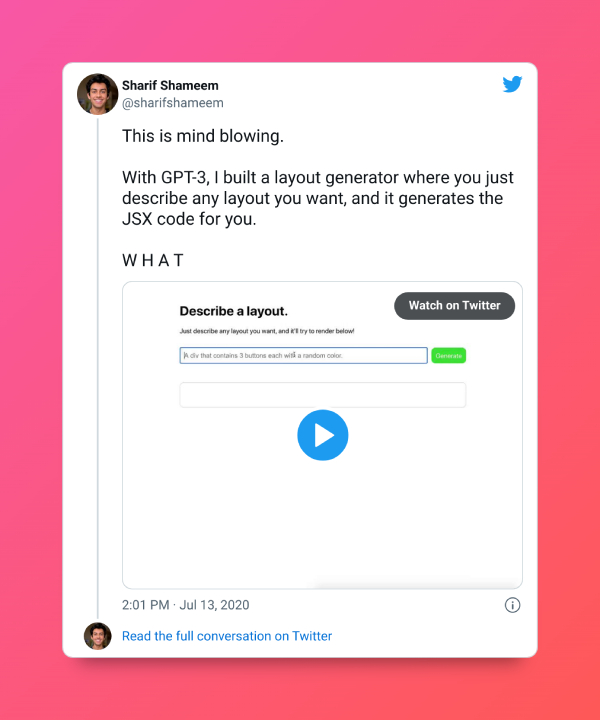In the age of Artificial Intelligence, we are bound for revolutionary inventions from time to time. GPT-3 or Generative Pre-trained Transformer 3 is not new in the scene but a convincing upgrade to GPT-2. So, what is GPT-3?
In layman’s terms, GPT-3 is a machine learning model with extensive training to prepare any text. It is developed by OpenAI, the developer of its predecessor, GPT-2 which features Elon Musk, among its renowned founders.
Also Read: What is Deep Learning?
A Brief History
OpenAir, the developers of GPT-3, had earlier developed GPT-2 AI language model in 2019. The language model was a breakthrough in the AI sector. It had a massive 1.5 Billion parameters. However, later that year, NVIDIA’s Megatron eclipsed that by reaching 8.3 Billion parameters. It was enormous given the significant number of parameters it included; later, Microsoft’s NLG bettered NVIDIA by scoring 17 Billion parameters. But, on 11th June 2020, OpenAI’s latest language model, GPT-3, surpassed NLG’s parameter and achieved a massive 173 Billion, ten times that of Microsoft’s NLG.
What is GPT-3?
GPT-3 is an AI that uses deep learning to produce human-like text responses. It is currently the most powerful AI that can make human-like texts and easily outperforms other models released before it. The language model has been trained with enormous amounts of internet data. A report by Forbes suggests the data size be 570 GB.
However, GPT-3’s training is mostly unsupervised. That is, it doesn’t always return accurate information. But, recently, its use cases have surprised the experts and they are exploring other numerous possibilities with it.
What can GPT-3 do?
OpenAI’s GPT-3 is a powerful AI quickly becoming a favorite tool for generating computer code, articles, fictional & non-fictional stories, etc. It creates natural-sounding texts against the data that has been fed to it.
GPT-3 is superior to GPT-2 and other language models. After a research team compared both the models, the earlier one outperformed the latter model. Given the assurance of its capabilities, OpenAI’s team releases a beta version of the language model to test its skills further.
As per OpenAI, more than 300 applications are using GPT-3 to power their search, text completion, conversations, and other AI features. GPT-3’s diverse capabilities allowed sectors like education, entertainment, productivity, creativity, and gaming to use and get pleasing results.
One such example is Viable’s. The company is using GPT-3 to read and reply to customer feedback. It further educates the company about customer behavior by analyzing customer chat logs, reviews, etc.
Translation
A Twitter user named @michaeltefula used OpenAI’s GPT-3 to turn Legalese into English. He was shocked with the results he found as he had only trained the API with two examples.

This training will work exclusively and is different from the other GPT models. Here, the Prompt was given, and the machine learning went ahead and created the language model to deliver the specific task.
Equation Generator
A GPT-3 demo translates English text into LateX equations. Twitter user @sh_reya shared the video of the process.

Therefore, eclipsing its boundaries to make its contributions to complex equations.
Code Generator
@hturan tried creating a React with _variable name_ alone, and he was successful in his attempt. You can watch the video here.

@debuildHQ Startup founder Sharif Shameem tried OpenAi’s GPT-3 language model and tried to create a layout generator. His experiment worked, and the GPT-3 transformer architecture prepared a JSX code for the prompt.

Q&A
Users also tried GPT-3 to create an answering session that has gone deep after iterations.

There is a plethora of usage of the GPT-3 language model such as Impersonation, plot summaries, news articles, ads, copywriting, content marketing, Python, SQL, javascript, Figma, CSS, HTML, poetry, songs, Logic, common sense, concept blending, and many more.
How Does GPT-3 Work?
The GPT-3 language model works on the language prediction model. To elaborate, it takes a Prompt in text, and its algorithmic structure treats the inputted text as a language piece. From there on, it predicts the following sequence based on the Prompt.
Due to the vast parameter and a considerable amount of trained data set, GPT-3 has learned to predict and structure data.
Furthermore, there is intelligent semantic analytics embedded into GPT-3. GPT-3 not only learns the meaning of the inputted word but also understands its meaning. That way, it learns the applications of the words and differentiates between other words.
However, you will find that the response from the GPT-3 language model isn’t always correct in terms of Logic. Because the machine language is unsupervised, it hasn’t yet learned to differentiate between “Wrong” and “Right.”
Wrapping Up: GPT-3 Explained
Overall, GPT-3 is marching towards the goal it was trying to achieve. The beta API applications have broken the boundaries of their applications. In the future, we will see more real use cases that will clarify its capabilities.












